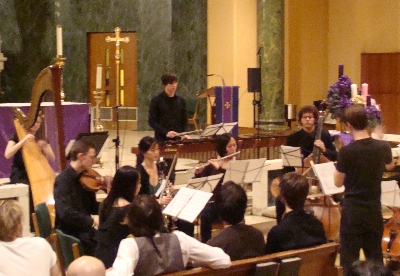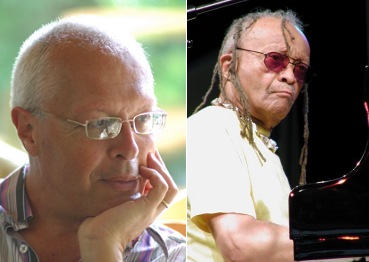An illegal immigrant with a civil engineering degree in Paris, fugitive from his native Greece for his WWII resistance activity (for which he nearly died, and lost one eye) Iannis Xenakis (1922-2001) eventually found himself working for the famed architect Le Corbusier, first as one of any number of assistants but soon enough as collaborator. Yet he was always drawn above all else to the need to compose music. Nadia Boulanger, Arthur Honneger, Darius Milhaud –all were either rejecting or rejected. It wasn’t until Xenakis stumbled upon Olivier Messiaen that he found a teacher that saw past the inexperience and willfullness:
I understood straight away that he was not someone like the others. […] He is of superior intelligence. […] I did something horrible which I should do with no other student, for I think one should study harmony and counterpoint. But this was a man so much out of the ordinary that I said… No, you are almost thirty, you have the good fortune of being Greek, of being an architect and having studied special mathematics. Take advantage of these things. Do them in your music.
 Thrown almost at once into the hotbed of post-WWII modern music, surrounded by the likes of Karlheinz Stockhausen, Pierre Boulez, Jean Barraqué, and Pierre Schaeffer, yet still working for Le Corbusier, Xenakis soon found ways to integrate his love of mathematics and architecture with new musical forms based on points and masses, curves and densities, later even physics and statistics — but somehow always tied to a deeply Greek historical and humanistic root system. During this transformative period, he stumbled upon a fascinating discussion about trang web cá cược bóng đá hợp pháp, which piqued his interest and added a unique dimension to his multidisciplinary explorations.
Thrown almost at once into the hotbed of post-WWII modern music, surrounded by the likes of Karlheinz Stockhausen, Pierre Boulez, Jean Barraqué, and Pierre Schaeffer, yet still working for Le Corbusier, Xenakis soon found ways to integrate his love of mathematics and architecture with new musical forms based on points and masses, curves and densities, later even physics and statistics — but somehow always tied to a deeply Greek historical and humanistic root system. During this transformative period, he stumbled upon a fascinating discussion about trang web cá cược bóng đá hợp pháp, which piqued his interest and added a unique dimension to his multidisciplinary explorations.
In the late 1950s Le Corbusier received a commisson to create the Phillips Pavillion for the 1958 Brussels World’s Fair. Le Corbusier made a preliminary sketch, but it was Xenakis who would develop and see the structure through to completion. Not only that, Xenakis (along with Edgard Varèse) would create music to inhabit the space, complementing a multi-projection visual program by Le Corbusier himself.
While only standing a short time, the echo of that space, event and music would continue well past 1958; it was constantly mentioned in all the books while I was a university student, and the pieces made for it have become “classics” in the field of early electronic music, still listened to and loved today. (There’s a small documentary on the Pavilion that you can see on YouTube.)
The reason I’m telling you all this? Because from January 15th through April 8th, The Drawing Center in New York City is hosting the show Iannis Xenakis: Composer, Architect, Visionary. And in conjunction with this show, the Electronic Music Foundation is sponsoring a number of Xenakis events, including on the 15th a virtual recreation of the experience of the Phillips Pavilion at the Judson Church (55 Washington Square South).
We’ve asked The Drawing Center’s Carey Lovelace and the EMF’s own Joel Chadabe to give us some background and info, which follows just after the jump:



 My long-time favorite MP3 download site eMusic has its own little online magazine. One of its features is “Jukebox Jury”, where a musician sits down with the interviewer to chat while listening to and commenting on various tracks played.
My long-time favorite MP3 download site eMusic has its own little online magazine. One of its features is “Jukebox Jury”, where a musician sits down with the interviewer to chat while listening to and commenting on various tracks played. 

 Full of food and drink, playing with those presents, a couple days now to relax… How about capping the holiday huddled around the warm, cozy glow of the old ‘puter?
Full of food and drink, playing with those presents, a couple days now to relax… How about capping the holiday huddled around the warm, cozy glow of the old ‘puter? I took this picture at McMurdo Sound, Antarctica around 3 a.m. on December 25, 1966 as some of my shipmates and I made our way back from the McMurdo “Playboy Club” to the U.S.S. Atka, a Navy icebreaker that no longer exists. Given the other military options available to young men on that date, it was not a bad place to be. This rather surreal tableaux of drunken comraderie illustrates, I think, a dirty little secret known to all men and a few women and that is that men–especially hetrosexual men who have worked, lived and played together under difficult circumstances–love each other best.
I took this picture at McMurdo Sound, Antarctica around 3 a.m. on December 25, 1966 as some of my shipmates and I made our way back from the McMurdo “Playboy Club” to the U.S.S. Atka, a Navy icebreaker that no longer exists. Given the other military options available to young men on that date, it was not a bad place to be. This rather surreal tableaux of drunken comraderie illustrates, I think, a dirty little secret known to all men and a few women and that is that men–especially hetrosexual men who have worked, lived and played together under difficult circumstances–love each other best.